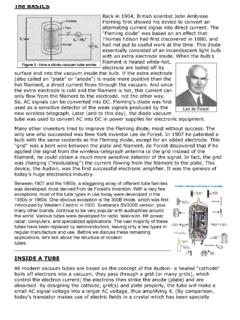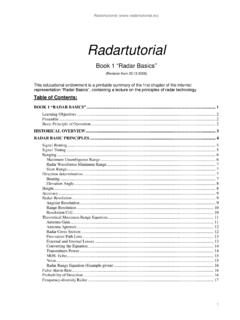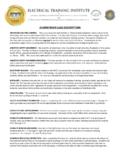Transcription of White Paper: Material Selection and Compatibility ...
1 Technical Note00840-0100-3045, Rev BASeptember 2015 FOR MORE INFORMATION ON ROSEMOUNT PRESSURE TRANSMITTERS:Contact an Emerson representative: 1-800-999-9307 Visit Selection and Compatibility Considerations for Rosemount Pressure Transmitters2 Technical Note00840-0100-3045, Rev BARosemount Pressure TransmittersSeptember potential for damage due to corrosion is an important concern in the design of instrumenta-tion for most process control systems. Rosemount pressure transmitters are available with several choices of materials of construction that can be expected to perform well in a wide range of applications.
2 This technical data sheet briefly discusses some of the reasons why incompati-bilities occur and the problems that can result. References are given to assist the user in making the appropriate Material choices for an information presented here is intended only as a guide to the Selection of Material options. Any Material will behave differently under the influence of such variables as temperature, pressure, flow rate, abrasives, and contaminants. All of the components of a process fluid should be considered when selecting materials. Fluids of a homogeneous chemical composition may react differently with a Material than fluids of a heterogeneous composition.
3 Additionally, even the presence of trace amounts of a chemical will impact Material Selection . It is the user's responsibility to make a careful analysis of all process parameters when specifying materials. Emerson Process Management cannot guarantee that a Material is suited to a particular application under all possible process materials other than the standard materials discussed here are needed, contact your local Emerson sales office for basicsCorrosion is the gradual destruction of a metal by chemical or electrochemical means. The most generic form of corrosion is galvanic corrosion. A combination of a cathode, an anode, and an electrolyte must be present for this type of corrosion to occur.
4 This combination of cathode, anode, and electrolyte is called a galvanic cell. Simply stated, a galvanic cell consists of two electrically connected, dissimilar metals and a medium, usually an aqueous solution, by which electron transfer can take fully understand the corrosion process, these terms must be better The electrode at which chemical oxidation occurs (or + current leaves the electrode and enters the electrolyte).Cathode The electrode at which chemical reduction occurs (or + current enters the electrode from the electrolyte). A potential difference results when the electrically connected anode and cathode are separated by a physical distance in a conductive media.
5 This potential difference causes the positively charged cations to flow from the anode to the cathode through the conductive medium. To complete the circuit, the negatively charged electrons flow from the anode to the cathode through the electrical connection. The resulting corrosion takes place at the anode. The cathode may also corrode, but not to the same loss of electrons by the anode is called oxidation, and it causes the metal surface to become positively charged. These positively charged metal ions on the surface, called cations, attract the negative ions (anions) found in the electrolyte to form a new compound.
6 This new compound no longer has its former metal characteristics, but rather it takes a new form such as rust or iron Note00840-0100-3045, Rev BARosemount Pressure TransmittersSeptember 2015 PressureThe gain of electrons at the cathode is referred to as reduction. Reduction allows the metal at the cathode area to retain its metallic characteristics (see Figure 1-1 on page 3).The tendency for corrosion to occur is governed by the magnitude of potential difference developed between the anode and the cathode. Generally, those metals with the highest potentials are at the anodic end of the galvanic series (see Ta b l e 1 - 1).
7 Metals with the lowest potentials are at the cathodic end of the series. However, the level of potential can vary with different conditions and with different environments. In general, the farther apart the metals are positioned on the galvanic chart, the more likely they are to corrode when placed together in a of corrosionGenerally, all corrosion is interrelated; however, it can take many forms. Corrosion can be uniform or localized. It may also combine with other forms of attack to produce even more undesirable effects. In the following discussion, some of the most common forms of corrosion are presented, including a separate section on sulfide stress corrosion This is characterized by an even distribution of corrosion that leaves the surface clean or coated with corrosion products.
8 This even distribution is due to the movement of the anodic and cathodic sites on the metal's surface. With uniform attack, fouling of the metal is usually a bigger problem than 1-1. Classic Corrosion CellAs current flows through the electrolyte from the anode to the cathode, an anodic reaction (Fe = Fe++ + 2e ) results. Simultaneously, the iron ion, Fe++, is liberated and combines with the OH to produce ferrous hydroxide, Fe(OH)2. Next, the ferrous hydroxide combines with oxygen and water to produce ferric hydroxide, Fe(OH)3, or common iron rust. 1. Electrolyte is seawater. Fe (OH)3Fe ++OH H2 OElectron FlowFe CathodeWATER (ELECTROLYTE)(1)O2O2Fe 4 Technical Note00840-0100-3045, Rev BARosemount Pressure TransmittersSeptember of the most destructive forms of corrosion is pitting.
9 It is a form of localized attack that causes small holes to form in the metal. It is promoted by low-velocity, stagnant-type conditions where concentrated bubbles of corrosives could form. Pitting is often difficult to detect because the pits may be covered by corrosion by-products. Pitting may take months to years before its effects are , once started, a pit penetrates the metal at an ever increasing rate. Pitting also has a tendency to undercut the surface. This makes detection even more difficult and subsurface damage more severe than the surface condition corrosionWhen two dissimilar metals come into contact and are immersed in a conductive medium, an electric potential develops.
10 The corrosion rate of the more active (anodic) metal increases whiles the corrosion rate of the more noble (cathodic) metal decreases. The resulting corrosion can be uniformly distributed or is the increase in rate of attack on a metal from abrasive effects. It can be characterized by grooves, holes, and waves, but usually exhibits a directional pattern. This form of corrosion is more common in the softer metals, and usually occurs after the protective film on the surface of the metal has been stripped Note00840-0100-3045, Rev BARosemount Pressure TransmittersSeptember 2015 PressureNoteTa b l e 1 - 1 was adapted from ASTM G82-98 (2014).













